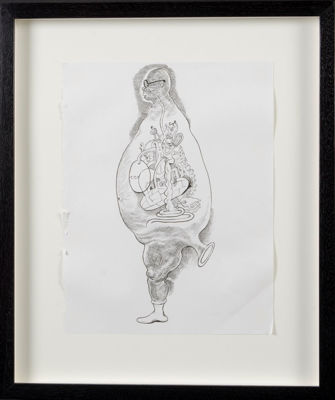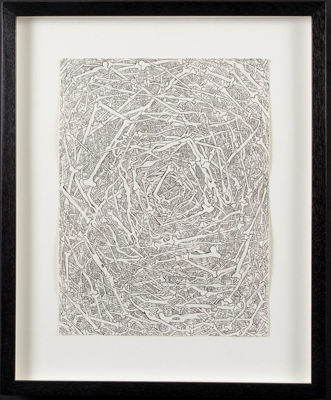Trenton Doyle Hancock
Trenton Doyle Hancock was born in 1974 in Oklahoma City, Oklahoma. Raised in Paris, Texas, Hancock earned his BFA from Texas A&M University, Commerce, and his MFA from the Tyler School of Art at Temple University, Philadelphia. Hancock’s prints, drawings, and collaged-felt paintings work together to tell the story of the Mounds—a group of mythical creatures that are the tragic protagonists of the artist’s unfolding narrative. Each new work by Hancock is a contribution to the saga of the Mounds, portraying the birth, life, death, afterlife, and even dream states of these half-animal, half-plant creatures. Influenced by the history of painting, especially Abstract Expressionism, Hancock transforms traditionally formal decisions—such as the use of color, language, and pattern—into opportunities to create new characters, develop sub-plots, and convey symbolic meaning. Hancock’s paintings often rework Biblical stories that the artist learned as a child from his family and local church community. Balancing moral dilemmas with wit and a musical sense of language and color, Hancock’s works create a painterly space of psychological dimensions. Trenton Doyle Hancock was featured in the 2000 and 2002 Whitney Biennial exhibitions, one of the youngest artists in history to participate in this prestigious survey. His work has been the subject of one-person exhibitions at Contemporary Arts Museum, Houston; Modern Art Museum of Fort Worth; and Museum of Contemporary Art, North Miami. The recipient of numerous awards, Hancock lives and works in Houston, where he was a 2002 Core Artist in Residence at the Glassell School of Art of the Museum of Fine Arts, Houston.
Sort by
Display per page
Title: Cave Scape No. 3
Artist: Trenton Doyle Hancock
Through pop-amalgams of comic strip, op art and referrals back to the density and detail in composition of artists such as Dürer or Bruegel the Elder, Hancock forms complex, sprawling drawings such as “Cave Scape 3” that offer a commentary on morality, good versus evil, and the breaking points between imagination and reality. Here, the reoccurring ‘Mounds’ (a creature both animal and plant that features across many of Hancock’s works) have been sunken into a landscape that modulates and oozes as mud or viscous liquid, the land scattered with objects that equally evoke a playground or rubbish heap.




